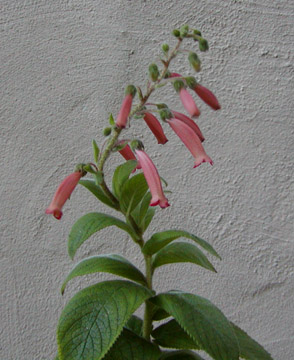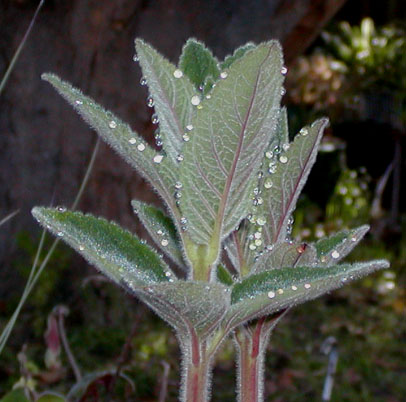| Species list |
Hybrids list |
Tubers list |
Topics list |
Site index |
What's new |
Home page |

This is one of the tall sinningias. It prefers quite a bit of sunlight.
This picture was taken in September 2005.
Sinningia sceptrum has a much wider range than most Sinningia species, which are confined to the Atlantic forests and mountains of Brazil. The Smithsonian's Gesneriad Checklist showed that this species is also found in Peru and Ecuador.
When grown from seed, the plant positions its tuber well down into the soil. This indicates that the tuber should be planted beneath the soil line, which is typical of most sinningias which grow in full sun. I have not seen this plant growing in the wild, but I suspect that it grows in clumps of several plants, with the tall stems supporting one another, since that is how S. curtiflora and S. elatior grow.

Dew in the morning on two shoots of Sinningia sceptrum, May 2006. The dew collects on the points of the leaves.
| Plant Description |
|
| Growth | Indeterminate |
| Habit | Upright stem |
| Leaves | Green, opposite or in whorls of three |
| Dormancy | Stems deciduous. Dormancy appears to be obligate |
Flowering |
|
| Inflorescence | extended axis |
| Season | Blooms in late summer |
| Flower | Pale red, tubular |
Horticultural aspects |
|
| From seed | Two years to bloom, under my conditions |
| Hardiness | Has survived 30 F (-1 C) in my back yard. |
| Recommended? | Yes and no. It is sturdy and relatively easy to grow, but its flowers are nothing special. |
Botany |
|
| Taxonomic group | The mixed-up group of the Corytholoma clade. |
Mauro Peixoto's Brazilian Plants site has a page about S. sceptrum.
by Martius (1829) as Gesnera sceptrum
by Wiehler (1975) as Sinningia sceptrum.
Etymology: Latin sceptrum ("scepter").